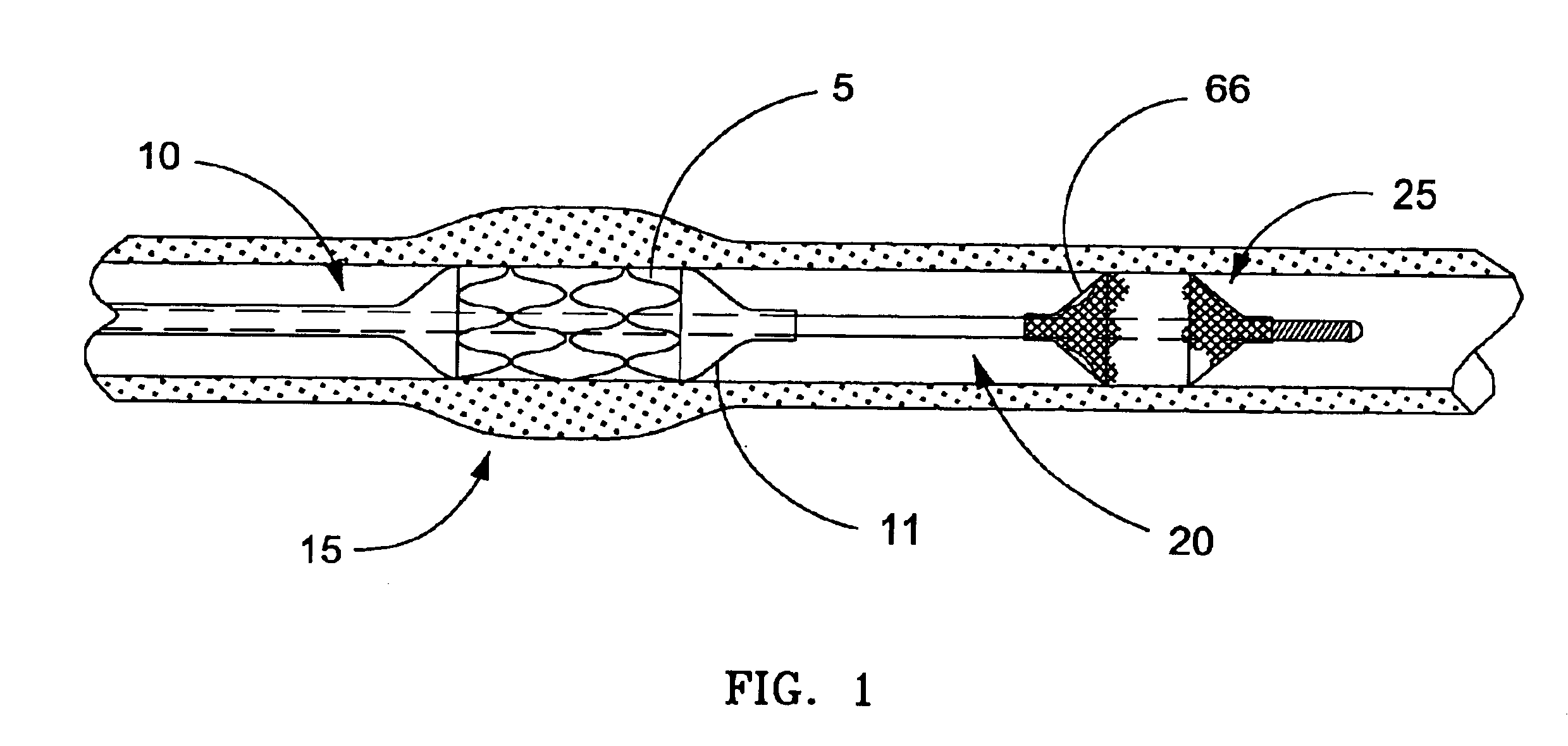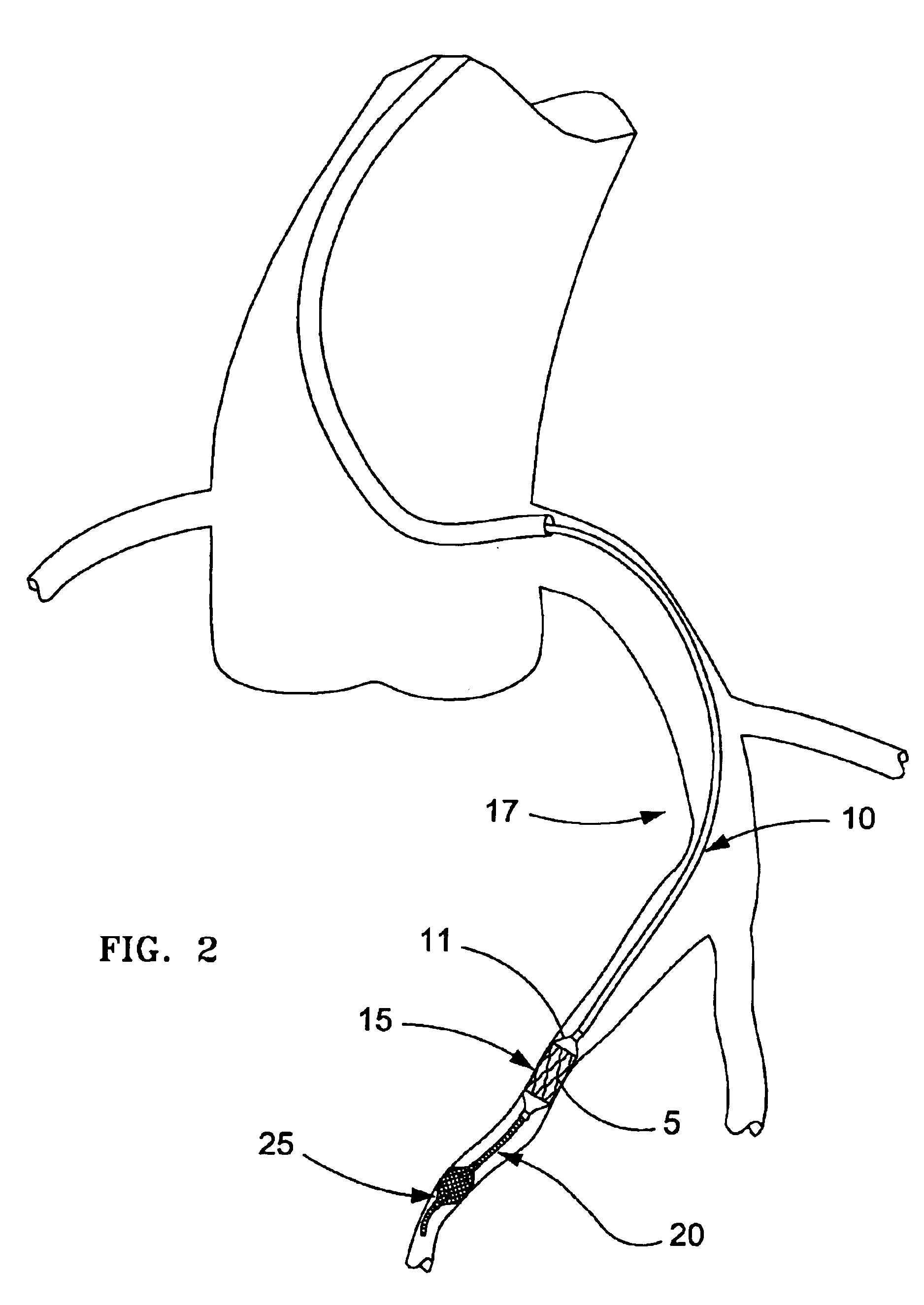Temporary intraluminal filter guidewire and methods of use
a filter guidewire and guidewire technology, applied in the field of intraluminal devices, can solve the problems of limiting the ability of the guidewire to negotiate tortuous vascular anatomy, infarction or stroke, guidewire-based filter devices do not have the handling characteristics expected of steerable guidewires, etc., to achieve the effect of enhancing radiopacity and minimizing the effect of physical properties of the wires
- Summary
- Abstract
- Description
- Claims
- Application Information
AI Technical Summary
Benefits of technology
Problems solved by technology
Method used
Image
Examples
first embodiment
Referring now to FIG. 5, in the invention, filter guidewire 20 includes core wire 42 and flexible tubular tip member 43, which is preferably a coil spring, fixed around the distal end of core wire 42. Thin wires made from stainless steel and / or one of various alloys of platinum are commonly used to make such coil springs for use in guidewires. Core wire 42 can be made from shape memory metal, such as nitinol, or preferably is a stainless steel wire tapered at the distal end. For treating small caliber vessels such as coronary arteries, core wire 42 will preferably measure about 0.006 inch (0.15 mm) in diameter.
Tubular shaft 44 is slidably disposed around core wire 42, and includes relatively stiff proximal portion 46 and relatively flexible distal portion 48. Proximal portion 46 is preferably made from thin walled stainless steel tubing, usually referred to as hypotubing, although other metals can be used. Various metals or polymers can be used to make relatively flexible distal por...
second embodiment
FIG. 6 depicts the invention in which filter guidewire 51 incorporates a typical steerable guidewire 55 and deploys a self-expanding filter. Guidewire 55 comprises core wire 52, including a tapered distal end, and flexible tubular tip member 54, which is preferably a coiled spring, fixed there around. At least a distal portion of tip member 54 is preferably made from radiopaque metal wire, such as an alloy of platinum. Self-expanding filter 25 is mounted about guidewire 55, with filter distal and proximal ends 27, 29 being mounted slidably there along and, optionally, being fitted with radiopaque markers (not shown). Filter proximal end 29 is attached to actuator 63 using adhesive or solder. Actuator 63 is mounted slidably about guidewire 55 and is preferably made of shape memory metal, such as nitinol. Actuator 63 is illustrated in FIG. 7, with alternative actuators 163, 263 and 363 depicted in FIGS. 8, 9 and 10, respectively. In actuator 163, a series of ridges having increasing d...
third embodiment
FIG. 11 illustrates the invention in which filter guidewire 50 also incorporates steerable guidewire 55, as described above with respect to filter guidewire 51. In filter guidewire 50, the mounting arrangement of filter 25 is reversed with respect to filter guidewire 20, such that filter distal end 27 is slidably mounted around and adjacent to the distal end of guidewire 55, and filter proximal end 29 is fixed to guidewire 55. Elongate tubular actuator 60 is slidingly and coaxially disposed around guidewire 55 proximal to filter 25. Link 65 movably extends through opening 66 in filter 25 adjacent filter proximal end 29 and connects the distal end of actuator 60 to filter distal end 27. Opening 66 is one of the inlet openings of filter 25, however any opening large enough to slidably pass link 65 will suffice. For example, a standard or over-sized pore in filter 25 may permit link 65 to extend therethrough. Actuator 60 can be made from thin walled metal tubing, such as stainless stee...
PUM
 Login to View More
Login to View More Abstract
Description
Claims
Application Information
 Login to View More
Login to View More - R&D
- Intellectual Property
- Life Sciences
- Materials
- Tech Scout
- Unparalleled Data Quality
- Higher Quality Content
- 60% Fewer Hallucinations
Browse by: Latest US Patents, China's latest patents, Technical Efficacy Thesaurus, Application Domain, Technology Topic, Popular Technical Reports.
© 2025 PatSnap. All rights reserved.Legal|Privacy policy|Modern Slavery Act Transparency Statement|Sitemap|About US| Contact US: help@patsnap.com



